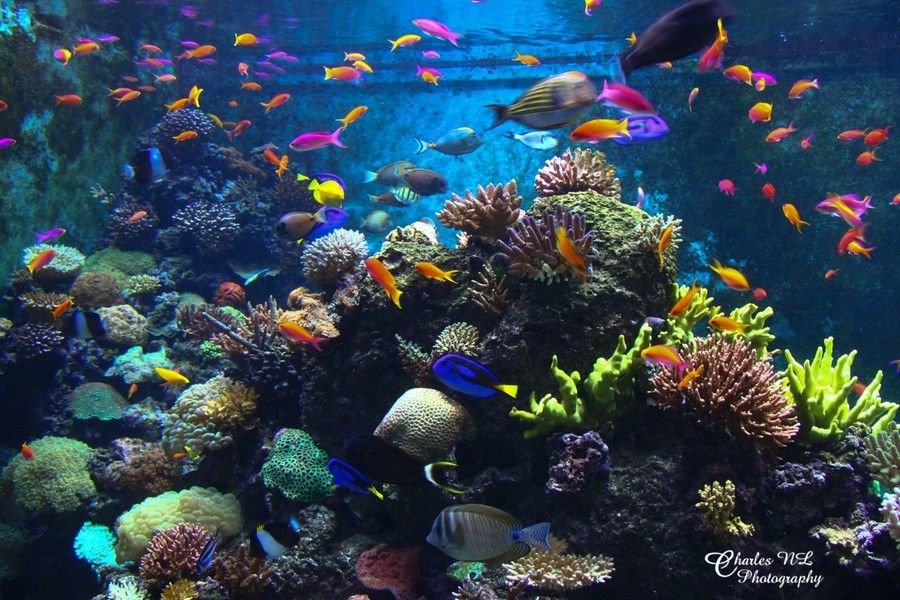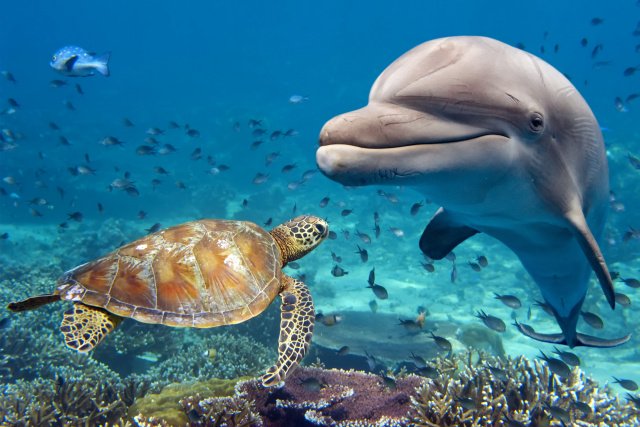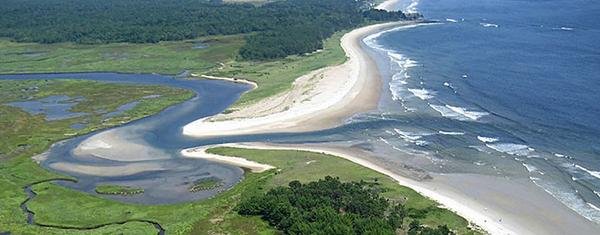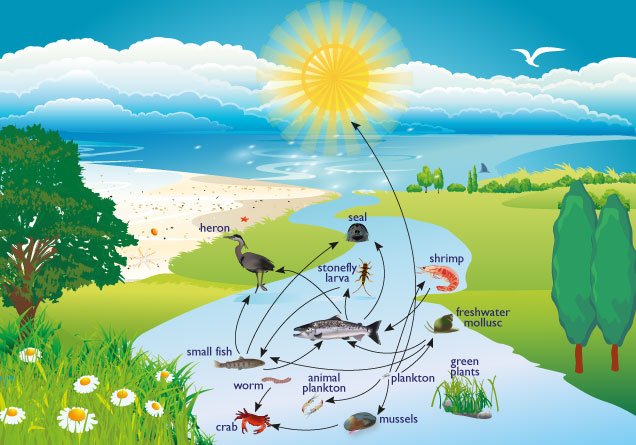Back to: BIOLOGY SS2
Welcome to SS2!
We are eager to have you join us in class!!
In today’s class, We will be discussing Aquatic Habitat. We hope you enjoy the class!

AQUATIC HABITAT
HABITAT (AQUATIC HABITAT)
A habitat is a place where organisms (plants, microorganisms and animals) are naturally found e. g. the habitat of the tadpole is the bottom of freshwater ponds or streams.
There are three main types of habitats, namely; aquatic habitat (in or around water), terrestrial habitat (in or on land) and arboreal habitat (in or on trees)
There are three kinds of aquatic habitat;
- marine/saltwater habitat e.g. ocean, seas
- brackish water habitat (where salt and freshwater mix) e.g. delta, lagoon, bay
- Freshwater habitat (contain little or no salt) e.g. lakes, rivers, streams.
MARINE HABITATS
Characteristics of marine habitats are as follow:
- The marine habitats constitute the largest habitat in the biosphere (70% of the earth’s area)
- They do not undergo sudden or rapid changes in physical factors such as temperature, PH and specific gravity. Hence they show the greatest stability of all habitats.
- Chemical composition:- marine water consists of many kinds of dissolved ions including Na+, K+, Mg2+, Ca2+, Pb43-, I–, NO3- t. c.
- Hydrogen (H+) concentration (PH): – saltwater is alkaline in nature with a PH of about 8.0 – 9.0 near the surface.
- Salinity (salt concentration of water). The seawater has high salinity. The average salinity of seawater is 35 parts per thousand.
- The density of marine water is high. It is about 1.028 while that of freshwater is 1.0. This allows many organisms to float in it.
- The temperature of the sea changes less quickly than that of the land. However, the temperature falls with an increase in the depth of the sea.
- Oxygen concentration is highest at the surface where the atmospheric oxygen dissolved in water. The concentration of oxygen decreases with depth.
- Waves are a temporary movement of surface water of the sea which occurs in any direction. They are caused by wind blowing against the surface of the water. They also bring about the mixing of seawater. Waves can also beat against the shore and sometimes caused it to be eroded.
- Tides are alternate rise and fall of the surface of the sea at least twice daily. Tides are caused by water distribution resulting from the combined gravitational pull of the earth by the sun and moon.
SELF EVALUATION
- What is a habitat?
- With two examples each, state the three kinds of aquatic habitats.
ZONATION OF MARINE HABITAT
HORIZONTAL ZONATION
The marine habitat is made up of the seashore and open sea. The major zones of the marine habitat are generally as follow
- Supratidal or splash zone is the exposed zone with occasional moisture being the area where water splashes when waves break at the shore.
- Intertidal or neritic zone is the planktonic zone which is exposed at low tide or covered by water at high tide. This zone has high photosynthetic activities because of abundant sunshine. Water temperature fluctuates.
- Subtidal or littoral zone is about 200m deep, constantly underwater, with abundant sunlight and nutrient.
- The benthic zone is about 500m deep with low light penetration and low nutrients. The water is dark, cold and with little oxygen. Hence, it is unfavourable for life.
- The abyssal or pelagic zone is about 7000m deep with low light penetration, low temperature and high pressure. The low light leads to low photosynthetic activities. Hence food production is primarily by chemosynthesis.
- The hadal or aphotic zone is the deepest, over 7000m deep. This forms the floor or the bed of the ocean. No light penetration or photosynthesis
VERTICAL ZONATION
Based on light penetration or depth, the marine habitat can be zoned into three ;
- Euphotic zone is the area in direct contact with sunshine. Hence, there is enough light penetration for photosynthesis. Therefore, producers, consumers and decomposer are all present.
- Disphotic zone is a region of dim light. Light penetrates the water with low too intensity for photosynthesis to take place. Consumers and decomposers are found in this zone.
- The aphotic zone is the bottom or bed of the seas and oceans. It is characterized by cold dark water without light penetration and very few living organisms.
SELF EVALUATION
- State the major zones of marine habitat
- Differentiate between the splash and hadal zones
DISTRIBUTION OF ORGANISMS AND ADAPTATION TO MARINE HABITAT
- Organisms of the splash zone include periwinkles; crustaceans e.g. ghost crab, seaweeds and sargassum (algae).
- Those of intertidal zone include starfish, sea anemones, sponges, sea urchin, annelids, Mollusca and barnacles.
- In the subtidal zone are snails, crabs, lobsters and crayfish.
- The benthic zone is unfavourable for life. The producers are absent, only a few saprophytic animals are present.
- The neritic zone house plankton (microscopic floating organisms e.g. diatom, algae, protozoa, crustacean and worms) and nekton (e.g. fishes, crabs, prawns and whales).
- Oceanic water house sharks, croaker, sea catfish, mackerel, Bonga fish e.t.c.

ADAPTATION OF ANIMALS TO MARINE HABITAT
Animals including barnacles, fishes, crustaceans e.t.c. found surviving in marine habitat do so with the following adaptive features;
- Barnacles have
i. protection mantle for attachment to rock shore and water retention.
ii. Cilia for feeding.
iii. A shell that prevents desiccation (drying up)
- Fishes possess
i. reduced or no kidney to retain urea in their body to cope with high salinity e.g. cartilaginous fishes like shark, dogfish etc.
ii. Salt secreting glands in their gills or eyes for maintaining osmoregulation (salt balance) e.g. bony fishes like tilapia, herring etc.
iii. Tube feet which enable them to hold on to rocky shores and hard shell to prevent desiccation e.g. starfish, whales.
- Whale has
i. fins for stability in water.
ii. An organ in front of the nostril for detecting pressure changes in water.
iii. A thick layer of dermal fat insulation or food reservoir.
- Shrimps possess powerful claws for holding food or prey.
- Periwinkles possess lungs for breathing and foot for attachment.
- Crabs burrow fast into the mud to protect them against predators, strong waves or hide.
ADAPTATION OF PLANTS TO MARINE HABITAT
Plants such as seaweeds, algae, sesuvium and diatoms are naturally found in marine habitat with the following adaptive features;
- Seaweeds have:
i. holdfast for attachment.
ii. mucilaginous cover to prevent desiccation.
iii. Divided leaves or floating devices for buoyancy.
- Algae (e.g. sargassum) have:
i. chlorophyll for photosynthesis.
ii. Small size or large surface area for floating in the water.
- Planktons (e.g. diatoms) possess:
i. air space in their tissues.
ii. Rhizoid for attachment to rocks.
iii. Air bladder for buoyancy (floating).
Examples of the food chain in a marine habitat include
- Diatom → crabs → tilapia
- Diatom →zooplankton → tilapia →shark
SELF EVALUATION
- Mention two organisms in the following zones: i. Splash, ii. Neritic, iii. Littoral, iv. Benthic
- Using 3 plants and 2 animals, explain adaptation in marine habitats.
ESTUARINE HABITATS (BRACKISH WATER HABITATS)
An estuary is a body of water formed at the coast where freshwater flowing towards the sea mixes with the sea (salt water) flowing inland. Estuarine habitats include deltas, lagoons and bays.

CHARACTERISTICS OF ESTUARINES
- The salinity fluctuates.
- The specific gravity is less than that of the sea.
- They have high turbidity due to frequent disturbances. Hence the rate of photosynthesis and respiration by organisms reduces.
- The water is shallow.
- They have a low diversity of species compared to marine habitat.
- They have a high level of nutrients
- They have low oxygen content, hence anaerobic activities are common.
PLANTS DISTRIBUTION AND ADAPTATION IN ESTUARINES
Plants found in estuaries include planktons, algae, red and white mangrove and they have the following adaptive features;
- Planktons (diatoms) have;
i. air spaces in their tissues.
ii. Rhizoid for the attachment to rocky shores.
iii. Air bladder for buoyancy
- Algae have:
i. chlorophyll for photosynthesis.
ii. small size or large surface area for floating in the water
- Red mangrove has;
i. stilt roots with rootlets that have air-spaces for air conduction to the root tissues and support to prevent washing away of the plant by the tide.
ii. Seeds which germinate while they are still on the parent plant, thus preventing the carrying away of the seedlings by the water current.
- White mangrove has pneumatophores (breathing roots) for gaseous exchange.

ANIMALS DISTRIBUTION AND ADAPTATION
Animals including mosquitoes, crustaceans, Mollusca, worms, fishes e.t.c. found in estuaries survive possessing the following features;
- Mosquito larvae and pupae possess breathing trumpets for gaseous exchange
- Crustaceans and water snails burrow into the mud against predators, strong waves or tides.
- Worms have strong protective and impermeable covering against high salinity.
- Mudskippers have fins for crawling on land and swimming in water.
- Fishes have fins for movement and swimming bladder for buoyancy.
FOOD CHAIN IN ESTUARINE HABITATS
- Detritus → worms → snails → birds
- Diatoms → shrimps →fishes
- Diatoms → small fish → sharks → man
SELF EVALUATION
- What is estuarine?
- List five characteristics of estuaries
FRESHWATER HABITATS
This is a body of water formed mainly from inland waters and it contains very low or no salt. Freshwater is of two types based on its mobility;
- Lotic freshwaters: – These are running waters flowing continuously in a specific direction e.g. rivers, springs, streams
- Lentic freshwaters: – These are stagnant waters which do not flow e.g. lakes, ponds, puddles, swamps and dams

CHARACTERISTICS OF FRESHWATER HABITATS
- It contains little or no salt. Salinity is 5 parts per thousand i.e. 0.5%.
- It is small in size.
- Oxygen concentration is high, being available in all parts of the water body, especially at the surface.
- The water is shallow, hence sunlight penetrates to the bottom.
- The temperature varies with seasons and depth.
- It has seasonal variation; decreasing or drying up in the dry season and increasing in the rainy season
- Water currents affect the distribution of organisms, salts and gases, especially in lotic freshwaters
PLANTS DISTRIBUTION AND ADAPTATION IN FRESHWATER
Plants of freshwater include water lily, spirogyra, water lettuce, water weeds e.t.c. and they have the following adaptive features;
- Water lily has:
i. air bladder.
ii. Expanded tips and lightweight which keep it afloat.
- Spirogyra has mucillagenous cover for protection
- Water lettuce has hairs in leaves to trap air and keep it afloat
- Waterweed (elodea) has a long and flexible petiole for swinging with water currents.
ANIMALS DISTRIBUTION AND ADAPTATION
Animals of freshwater habitats include protozoa, duck, pond skaters, hydra, fishes e.t.c. their adaptive features include
- Protozoa have contractile vacuole for osmoregulation in water.
- Duck has webbed feet for locomotion and serrated beak for sieving food in water into its mouth.
- Hydra has slippery surface, hooks and suckers for attachment to water particles.
- Pondskatters has long legs for skating on the water surface
- Fishes have swim bladders for buoyancy and gills for respiration
FOOD CHAIN IN FRESHWATER HABITATS
- Diatoms → fish fry →tilapia
- Spirogyra → tadpoles → carps → kingfish
- Algae → mosquito larva → small fish
SELF EVALUATION
- State five characteristics of freshwater habitats
- With three examples each that describe plants and animals adaptation to freshwater habitats
GENERAL SELF EVALUATION
- Give two examples of the food chain in marine habitats
- How do organisms adapt to life in an estuary?
- What is a freshwater habitat?
- Differentiate between lotic and lentic freshwater habitats
- Differentiate between waves and tides.
- According to light penetration, zone marine habitat.
We have come to the end of this class. We do hope you enjoyed the class?
Should you have any further question, feel free to ask in the comment section below and trust us to respond as soon as possible.
In our next class, we will be talking about Terrestrial Habitat. We are eager to meet you there.

More notes
More notes pls
I need more biology nd chemistry notes for SS2
I love this site
Keep it up.and add more notes
PLEASE WHY CAN’T I COPY?
You should have added definition of aquatic habitat,marine habitat and so on
Please I need to be serious I am new student
Glad you found it helpful😊 For even more class notes, engaging videos, and homework assistance, just download our Mobile App at https://play.google.com/store/apps/details?id=com.afrilearn. It’s packed with resources to help you succeed🌟
i love this site